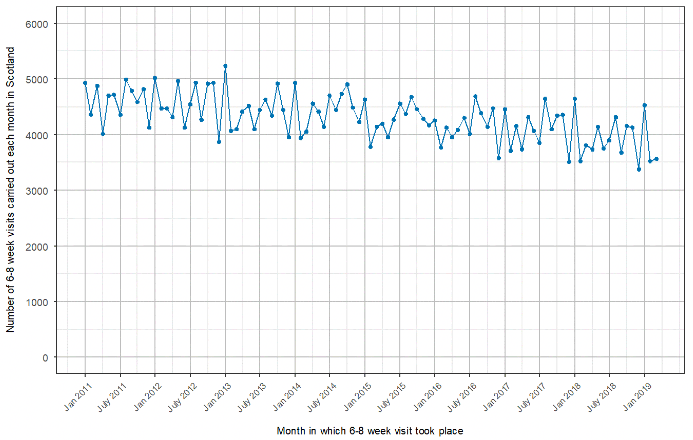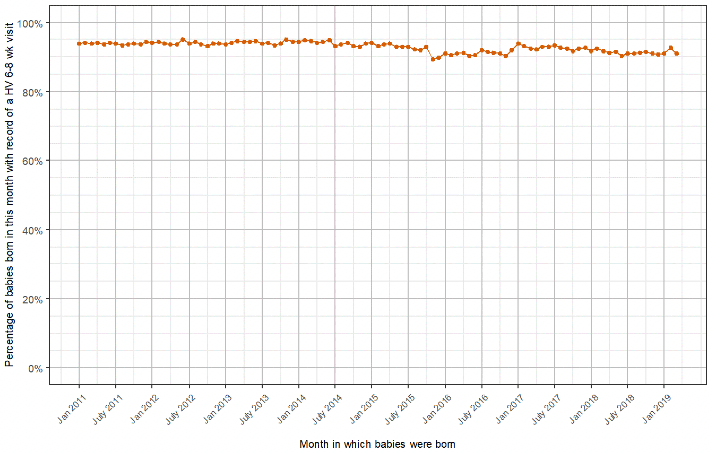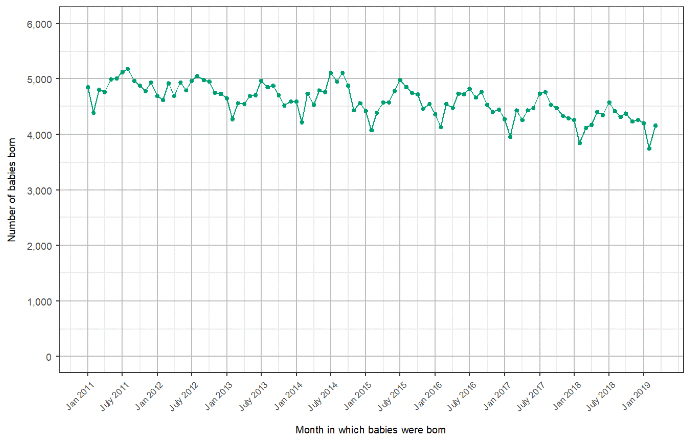Universal Health Visiting Pathway evaluation: phase 1 report - routine data analysis - implementation and delivery
The Universal Health Visiting Pathway was introduced in Scotland in 2015 to refocus the approach to health visiting in Scotland. This is the final report of four that provides findings about the implementation and delivery of the pathway as part of the national evaluation of Health Visiting.
6-8 week visit
Reviews provided each month
The number of 6-8 week visits provided each month are displayed in Figure 8. For the first two years the mean number of visits is 4,590; this decreases to 4,390 for the following three years, and 4,045 visits for the final three years, as the number of births also decreases.
Overall coverage
From Figure 9, it can be observed that coverage for the 6-8 week review is slightly lower and more varied than for the first visit. For the first half of the period (babies born between 1 January 2011 and 31 January 2015), average monthly coverage of the 6-8 visit is 94.1%. There is a distinct trough in coverage for babies born between 1 November 2015 and 31 December 2016, when the average coverage in this period falls to 90.9%. This trough coincides with the transition to the new 6-8 week child health review forms in February 2016: there were teething problems until staff got used to the new layout, and some staff continued to use the old version of the forms, which could not be entered easily into new screens as some data fields differed. Coverage then increases again to 93.9% in January 2017 before slowly declining each month to 91.1% at 31 March 2019


Coverage stratified by SIMD quintile
In Figure 10, the coverage is displayed by SIMD quintile. The highest and lowest quintiles are broadly parallel; babies born in the financial year 2011/12 have 96.0% coverage for children in the least deprived quintile (92.9% for those in the most deprived), and those born in 2018/19 coverage is 93.3% for those in SIMD 5 (88.6% in SIMD 1). Coverage for SIMD 2-4 quintiles lie between these two points.
Comparison of visit coverage between SIMD 1 and SIMD 5
As is apparent from Figure 10, the absolute difference between quintiles SIMD 1 and SIMD 5 is more pronounced for the 6-8 week visit compared to the first visit: it ranges from 3.1 percentage points for babies born in year 2011/12 to 4.7 percentage points for those born in 2018/19, with a mean of 3.8 percentage points (see Table 4). Relative difference (SIMD 5 / SIMD 1) is more constant, ranging from 1.03 to 1.05.

Notes to Figures 8-10
1. The 6-8 week review should be provided before the child reaches 12 weeks. However, gestational correction is required when scheduling reviews for children aged up to 24 months. Thus children born prematurely (at <37 completed weeks gestation) are scheduled for the 6-8 week review by their due date rather than their actual date of birth. Some 'late' reviews will therefore be due to appropriately delayed provision of reviews for preterm babies.
2. The review is deliverable from January 2011 and should therefore be delivered to all children born from January 2011 onwards.
3. Overall coverage = Number of children born in month with subsequent record of a health visitor 6-8 week visit on CHSP-PS (by May 2020) / Number of children born in month eligible for review.
4. Coverage of SIMD 1 reviews = Number of children born in financial year in SIMD 1 area with subsequent record of a health visitor 6-8 week visit on CHSP-PS (by May 2020) / Number of children born in financial year in SIMD 1 area who are eligible for review.
Source for Figures 8-10
The source for all child health data is CHSP-PreSchool May 2020, Public Health Scotland. The source for births data is NRS.
| Birth cohort (i.e. births occurring in financial year ending March 20XX) | Coverage of 6-8 week visit (%) | Absolute difference in coverage (SIMD 5 – SIMD 1) | Absolute difference in coverage: 95% CI | Relative difference in coverage (SIMD 5 / SIMD 1) | ||||
|---|---|---|---|---|---|---|---|---|
| SIMD 1 | SIMD 2 | SIMD 3 | SIMD 4 | SIMD 5 | ||||
| March 2012 | 92.87 | 93.81 | 94.65 | 94.87 | 96.00 | 3.13 | 2.55 to 3.71 | 1.034 |
| March 2013 | 92.50 | 93.85 | 94.80 | 94.93 | 96.98 | 4.48 | 3.92 to 5.04 | 1.048 |
| March 2014 | 93.38 | 94.19 | 94.43 | 95.17 | 96.62 | 3.24 | 2.67 to 3.80 | 1.035 |
| March 2015 | 92.43 | 93.75 | 94.02 | 94.61 | 97.00 | 4.57 | 4.00 to 5.13 | 1.049 |
| March 2016 | 90.10 | 92.42 | 92.38 | 92.94 | 93.64 | 3.55 | 2.84 to 4.25 | 1.039 |
| March 2017 | 90.38 | 91.27 | 91.77 | 92.93 | 93.45 | 3.08 | 2.36 to 3.79 | 1.034 |
| March 2018 | 91.05 | 92.01 | 92.47 | 94.01 | 94.71 | 3.66 | 2.97 to 4.34 | 1.040 |
| March 2019 | 88.56 | 91.53 | 92.21 | 92.57 | 93.26 | 4.71 | 3.93 to 5.49 | 1.053 |
Source:
The source for all child health data is CHSP-PreSchool May 2020, Public Health Scotland. The source for births data is NRS.
Contact
Email: justine.menzies@gov.scot
There is a problem
Thanks for your feedback